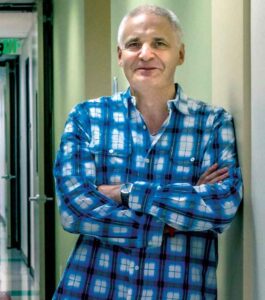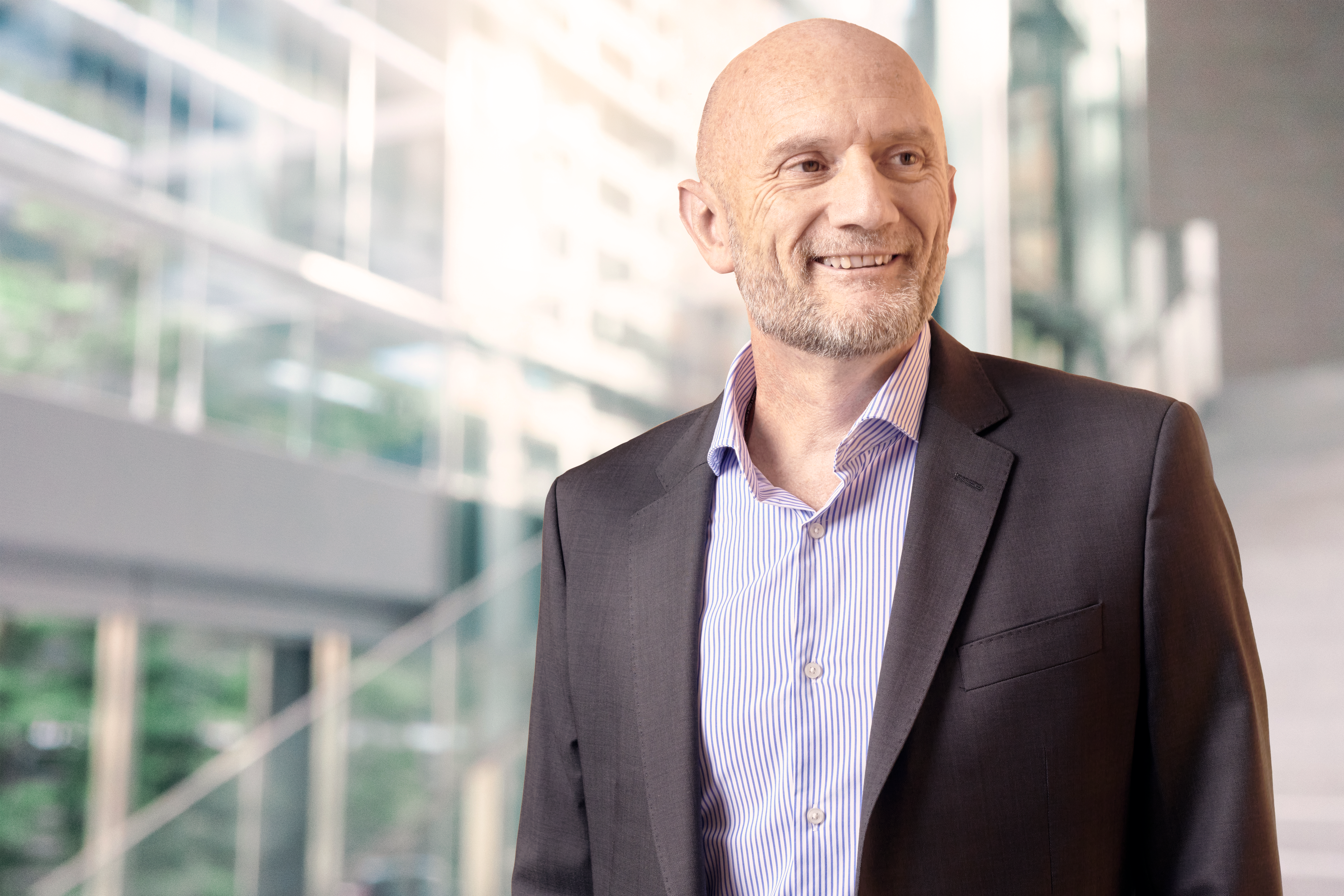Prescription for Success: The Power of Culture
When James Mackay became president and COO of biotech firm Ardea Biosciences in 2013, he immediately recognized the potential lying within the organizational culture.
“I saw an energized environment that allowed things to move more rapidly than in a big company,” he says.
Dr. Mackay also saw the opportunity to secure a big win for San Diego-based Ardea by capitalizing on its subject matter expertise—specifically its focus on drugs that treat gout, an inflammatory arthritis affecting more than 16 million people worldwide. A new approach to treating gout had not come to market in over half a century, creating a significant market gap with an underserved patient group. So Dr. Mackay issued a companywide challenge: Submit a new gout drug to the U.S. and European regulatory agencies in far less time than large pharma companies typically take.
The period between the last clinical visit of a patient during a drug trial and the submission of the drug to regulatory bodies normally ranges from 250 days to a year. Dr. Mackay challenged the team to cut that time down as much as possible, even though it would be the company’s first time conducting a regulatory submission.
250-365 days: Standard period between the last clinical visit of a patient during a drug trial and the submission of the drug to regulatory bodies
159 days: Period between the last clinical visit of the drug patient trials for Ardea’s gout drug Zurampic and when the company submitted it to U.S. and European regulatory agencies
A Shared Sense of Purpose
Dr. Mackay was confident the Ardea team could meet the bold challenge for two reasons: The company’s culture would support it, and the staff was united in a mission to improve the treatment of gout. “Gout is probably one of the most misunderstood and neglected diseases we have,” he says. “It has this stigma of being a disease that is the fault of the patient, a disease of excess.” Yet while diet does contribute to the disease, a genetic defect leads to the kidneys’ inability to excrete uric acid, causing buildup of uric acid crystals and painful inflammation of the joints. Whereas traditional gout medication inhibits the production of uric acid, Ardea’s new drug would increase the kidneys’ excretion of uric acid.
Dr. Mackay knew that Ardea’s shared sense of purpose led to a high job-satisfaction rate. That was something he wanted to hold onto even as he increased employee count by 70 percent. “They really enjoy working here, and they are really passionate about helping patients,” Dr. Mackay says. “That passion gives them a focus to drive the project forward as rapidly as possible, because they know that every day they take developing the drug is another day the patients don’t have access to it.”
To support the effort, Dr. Mackay worked to retain Ardea’s entrepreneurial culture, while making some tweaks to boost ROI. This meant introducing two key changes. First, he continually asked the staff to question how long a given task would take. Second, he created an open environment in which staff members felt they could raise any issue without getting blamed for it.
“I challenge hard, but I’m also very understanding if the staff comes back to me and says, ‘We can’t do it in that time frame, but we can do it in this time frame,’” Dr. Mackay says. “That’s very important in ensuring you have a project plan that’s challenging yet achievable.”
While Ardea had previously operated under a top-down leadership style in which the CEO made the decisions and the rest of the organization carried them out, Dr. Mackay knew Ardea could only get the drug submitted as speedily as possible if he empowered everyone to feel responsible and accountable. They could not wait on him to call all the shots.
“I set out to create an environment where the people who work with me can excel in what they do and have accountability for the areas they’re responsible for,” Dr. Mackay says. He knew that sense of empowerment would allow his team members to achieve more than they ever thought possible. “The culture prior to James taking the helm was a ‘sit and wait’ mentality. The majority of the employees had little or no experience with this type of submission and therefore they were ‘waiting’ to be taught or instructed,” says Jen Zimmer, a partner at Insigniam.
Dr. Mackay challenged his team to reduce project timelines by reimagining them entirely. “The team asked, ‘How much time do we need to shave off the plan?’” he recalls. “And I said to them, ‘What you need to do is tell me why we can’t submit the day after we close the trials.’”
While Dr. Mackay recognized that would be impossible, he wanted his team to stop assuming that certain tasks required specific lengths of time and instead think critically and creatively about how long any one task should take. He knew there was no magic bullet to save a big chunk of time, but small amounts of time saved from many steps would have a cumulative impact. “James constantly provided bold, inspirational leadership. He created an environment where committed action trumped experience, and innovation about how the work was done was respected. This in turn catalyzed the team focus and infused ownership of the timeline, which led to the breakthrough result,” Ms. Zimmer says.
The Final Verdict
Along with the cultural adjustments, Dr. Mackay also implemented a structural change. Traditionally, a single team works to submit a drug. Ardea created two teams: a submission leadership team, which consisted primarily of senior executives, and a submission delivery team. The latter included members from every department of the organization, such as regulatory and clinical, and reported directly to the leadership team (see “Division of Labor”). This integrated structure allowed each department to identify an issue in another department that could have a knock-on effect—and to take action sooner rather than later. “A problem in one area then becomes everybody’s problem to solve,” Dr. Mackay says.
The delivery and leadership teams each met weekly and, as the project progressed, daily. The leadership’s standing meetings could last from five minutes to five hours, depending on the problems at hand, but nothing was ever left to the next day. “The innovative team structure was a key piece in the project’s success. At Ardea, many of the worker bees are also the key leaders of work groups, so maximizing people’s time was critical,” Ms. Zimmer adds.
In December 2014, Ardea submitted its gout drug, Zurampic, to the U.S. and European regulatory agencies just 159 days after the last clinical visit of a patient—about half the length of time the process typically takes. A year later, the U.S. Food and Drug Administration approved the drug, followed just two months later by approval from the European Commission. The product is now being manufactured in Sweden with technical guidance from the Ardea team.
The benefits of the success spread beyond one individual drug—it was a confidence builder for the entire organization.
“That passion gives them a focus to drive the project forward as rapidly as possible, because they know that every day they take developing the drug is another day the patients don’t have access to it.”
—James Mackay, COO, Ardea Biosciences
“This organization now believes it can take a drug to market and patients,” Dr. Mackay says. “People here got to experience something most hadn’t experienced before: getting approval for a drug and then seeing it on pharmacy shelves.”
Ardea could not have realized that success without strategic alignment—starting from its leadership. Dr. Mackay says, “What you have to do as a leader—and I’ve seen so many leaders fail to do this—is that when you lay out your vision, every single action you take and every single word you say has to be aligned with that vision.”
For example, at one point the team had to check and analyze a large portion of data from the clinical trials—a process they estimated would take two weeks. “We said, ‘We’ve got a building full of scientists. Why don’t we get everybody to work on this?’” Dr. Mackay says. So for one weekend, the entire organization spent 14 hours quality-controlling the trials’ data. “We called it 14 days of work in 14 hours.”
Encouraging Escalation
That can-do, all-hands-on-deck work ethic stems partly from the no-blame environment Dr. Mackay established. “Normally the issues that cause delays to projects are issues that have been known for a long time but haven’t been made visible. And when they are made visible, it’s too late to do anything about them,” he says.
Dr. Mackay encouraged all of his team members to come forward as soon as they detected an issue that might delay the project—even if they did not need anyone else to do anything about it. That way, team members who raised a concern did not feel immediately disempowered—or blamed—for doing so. But if they needed help, they got it.
“In many organizations, when something’s escalated, people feel like they’ll just get in trouble, and often leaders act in a way that reinforces that,” Dr. Mackay says. “I encourage people to use escalation as a positive behavior, not a negative behavior.” Share on X
This attitude came in handy when, during Ardea’s statistical analysis of the clinical trials, staffers identified an error in a contractor’s programming that threatened to throw off a large amount of the data. “My guys were throwing their hands in the air, saying we’ll miss the submission date,” Dr. Mackay says. “This could’ve completely derailed the project.”
Rather than mirror his team members’ anxiety, Dr. Mackay calmly took action, bringing his team to meet with the contractor’s team. “If the leader doesn’t stay calm, all that does is increase the tension,” he says. “It became a very collaborative win-win, when it could’ve been a real finger-pointing situation.”
In the end, the analyses were corrected and the team stayed on track.




